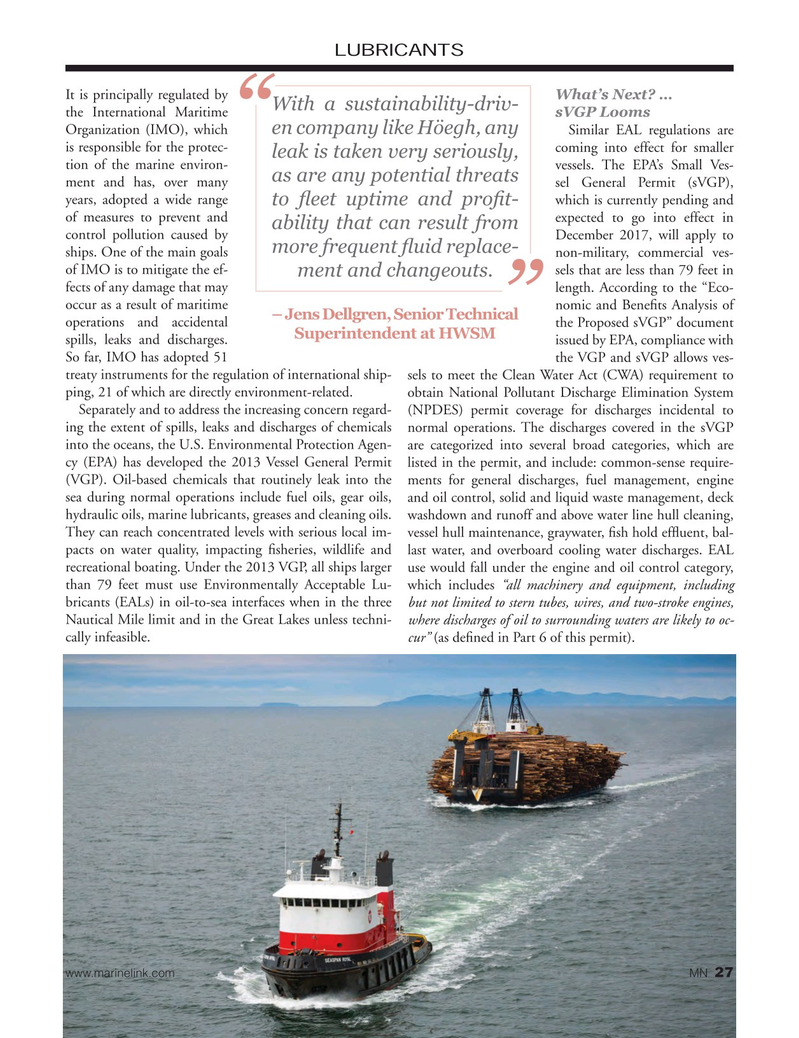
Page 27: of Marine News Magazine (June 2017)
Combat & Patrol Craft Annual
Read this page in Pdf, Flash or Html5 edition of June 2017 Marine News Magazine
LUBRICANTS
It is principally regulated by What’s Next? …
With a sustainability-driv- the International Maritime sVGP Looms
Organization (IMO), which Similar EAL regulations are en company like Höegh, any is responsible for the protec- coming into effect for smaller leak is taken very seriously, tion of the marine environ- vessels. The EPA’s Small Ves- as are any potential threats ment and has, over many sel General Permit (sVGP), years, adopted a wide range which is currently pending and to ? eet uptime and pro? t- of measures to prevent and expected to go into effect in ability that can result from control pollution caused by December 2017, will apply to more frequent ? uid replace- ships. One of the main goals non-military, commercial ves- of IMO is to mitigate the ef- sels that are less than 79 feet in ment and changeouts. fects of any damage that may length. According to the “Eco- occur as a result of maritime nomic and Bene? ts Analysis of – Jens Dellgren, Senior Technical operations and accidental the Proposed sVGP” document
Superintendent at HWSM spills, leaks and discharges. issued by EPA, compliance with
So far, IMO has adopted 51 the VGP and sVGP allows ves- treaty instruments for the regulation of international ship- sels to meet the Clean Water Act (CWA) requirement to ping, 21 of which are directly environment-related. obtain National Pollutant Discharge Elimination System
Separately and to address the increasing concern regard- (NPDES) permit coverage for discharges incidental to ing the extent of spills, leaks and discharges of chemicals normal operations. The discharges covered in the sVGP into the oceans, the U.S. Environmental Protection Agen- are categorized into several broad categories, which are cy (EPA) has developed the 2013 Vessel General Permit listed in the permit, and include: common-sense require- (VGP). Oil-based chemicals that routinely leak into the ments for general discharges, fuel management, engine sea during normal operations include fuel oils, gear oils, and oil control, solid and liquid waste management, deck hydraulic oils, marine lubricants, greases and cleaning oils. washdown and runoff and above water line hull cleaning,
They can reach concentrated levels with serious local im- vessel hull maintenance, graywater, ? sh hold ef? uent, bal- pacts on water quality, impacting ? sheries, wildlife and last water, and overboard cooling water discharges. EAL recreational boating. Under the 2013 VGP, all ships larger use would fall under the engine and oil control category, than 79 feet must use Environmentally Acceptable Lu- which includes “all machinery and equipment, including bricants (EALs) in oil-to-sea interfaces when in the three but not limited to stern tubes, wires, and two-stroke engines,
Nautical Mile limit and in the Great Lakes unless techni- where discharges of oil to surrounding waters are likely to oc- cally infeasible. cur” (as de? ned in Part 6 of this permit).
www.marinelink.com MN 27

 26
26

 28
28
